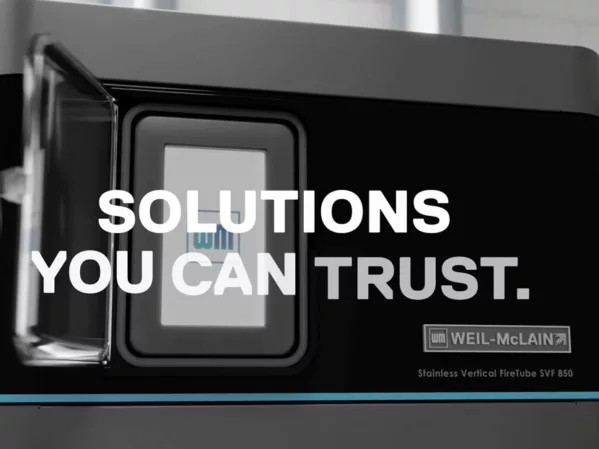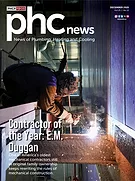As the economic effects of COVID-19 linger, what can we expect 2022 to deliver for those in the plumbing manufacturing and construction industries?
Economic trends, such as rising prices for raw materials; challenges, including supply chain issues and labor shortages; and technology disruptors, such as the Internet of Things (IoT), will require manufacturers, suppliers, contractors and retailers to be nimble in the coming year.
In the plumbing manufacturing industry, we’re bullish not only about the continued demand for plumbing fixtures and fittings, but also about steps being taken to improve drinking water safety and public health — namely, the much-anticipated bipartisan Infrastructure Investment and Jobs Act enacted late in 2021.
Market Segments Poised for Growth
Several construction market segments are poised for growth in 2022, including multiunit housing, commercial development and residential remodeling. This construction will keep plumbing fixtures and fittings in high demand, notes the 2021 third-quarter Plumbing Manufacturers International (PMI) Market Outlook.
Multiunit housing development, which stalled for several years, has been ticking up. In August 2021 — for the first time since 2013 — the number of multifamily housing units matched the volume of single-family housing units under construction. Each segment totaled 702,000 units, according to an October 2021 National Association of Homebuilders (NAHB) report.
Several factors are driving this trend, most notably tight inventory for single-family homes and the resulting higher prices, which have knocked some buyers out of the single-family home market and pushed others to consider multifamily housing. Home buyers may catch a break this year as Freddie Mac forecasts home price growth to slow from 16.9 percent in 2021 to 7 percent in 2022 (https://bit.ly/3xMtW8n).
Interestingly, the increased cost of single-family homes has given rise to a new investment opportunity for single-family home rentals or rent-to-own home ownership programs that are funded by large investment firms.
Single-unit housing construction will slow in 2022 as home builders’ prices continue to rise due to sustained supply limitations and higher material costs. The PMI Market Outlook forecast shows that supply chain issues, stimulus spending and strong demand for housing — bolstered by Gen X and Gen Y buyers — will nudge materials prices higher into 2022.
The NAHB affirms that everything from framing lumber, plywood and copper wiring, to appliances, doors and plumbing fixtures and fittings is in short supply. The erratic changes in materials pricing have become especially challenging for builders who need to plan and quote pricing for jobs that can take months or more to complete.
Nonresidential construction, which took a hit in 2020 and 2021 as workers retreated to their home offices during the pandemic, is set to bounce back with strong single-digit growth in 2022 and 2023, according to the PMI Market Outlook. The report notes a decrease of 3.1 percent in nonresidential construction for the first eight months of 2021, with gains of 6.3 percent and 5.9 percent forecasted for 2022 and 2023, respectively.
Many companies made the work-from-home option permanent, leaving multiple office and commercial buildings vacant. Builders saw an opportunity to supplement the nationwide housing shortage by converting some of those vacant buildings into apartments.
More than 20,100 apartment conversions — a record number — were to be completed in 2021, according to an October 2021 rentcafe.com article (https://bit.ly/3lt2WG2). The article stated that this trend will continue into 2022 with more than 52,700 converted units expected to become available. One-quarter of those conversions are in former offices.
Meanwhile, residential remodeling is expected to continue experiencing strong growth into 2022. The Joint Center for Housing Studies of Harvard University said that homeowners could spend $400 billion on repair and improvement by the third quarter of 2022 (https://bit.ly/3EfkXik).
However, the rising costs of labor and building materials, coupled with increasing interest rates, could dampen that growth. Of note, the Mortgage Bankers Association is forecasting 30-year mortgage rates, which hovered near 3 percent in 2021, to start climbing to percent in 2022 (https://bit.ly/3pioNB2).
Pandemic Proves Fragile Nature of Supply Chains
COVID-19 and its repercussions helped further prove the fragile nature of our supply chains.
Take, for example, the deep freeze in Texas in February 2021, which forced the world’s largest petrochemical plants to shut down. Within a few hours, the weather event closed 75 percent of polyethylene capacity, 62 percent of polypropylene capacity and 57 percent of PVC volume, according to a March 2021 Wall Street Journal article (https://on.wsj.com/3xKRM4d).
As a result, many plumbing manufacturers could not get plastic resin to mold plastic parts they typically use in their toilets and other plumbing products.
Supply chain issues were further exacerbated throughout 2021 by a logjam of cargo ships at West Coast ports, causing container shortages and escalating shipping costs amidst staffing voids in the logistics industry. Production cuts in countries such as China, which has been dealing with a power shortage, are making matters worse.
Years of managing lean supply chains and systems with a limited bandwidth and competing interests from multiple users — from plumbing and other manufacturers to contractors to retailers — has made it obvious that a large-scale recalibration needs to take place. Changing tax implications, more restrictive trade policies and ever-changing government regulations are additional factors prompting the need for a global rebalancing of supply chains.
For manufacturers and businesses to recover and remain resilient for the long term, they will need to properly prepare while seeking ways to innovate. That will mean doing things such as recalibrating supply chains with a mix of domestic, local and international sources, and using technology such as 5G and IoT to keep supply chains transparent and collaborative.
The 2022 Annual Third-Party Logistics Study (3PL Study, https://bit.ly/3lokwuI) explored more ways to bolster supply chains — with investments in the circular economy and reverse logistics to enhance environmental sustainability and lean warehousing to reduce unnecessary travel time and other activities that don’t add value.
Further relief can come from ports expanding their hours so more containers can be unloaded off ships. The Biden administration announced in October 2021 that it would start with two ports in California — the Port of Los Angeles and the Port of Long Beach — which would begin operating around the clock, Yahoo.com reports (https://yhoo.it/3rtbEYx).
Labor Lacking Across Construction and Related Industries
Eye-opening reports are confirming what so many in the plumbing, construction, manufacturing and logistics industries continue to struggle with: a sustained worker shortage.
A September 2021 study by the Associated General Contractors of America and Autodesk revealed that 89 percent of contractors are having trouble finding craft workers, while 61 percent of construction firms reported project delays because of workforce shortages (https://bit.ly/3EhZx4j). A 2021 U.S. Chamber of Commerce survey found that 35 percent of contractors had to turn down work because of a lack of labor (https://bit.ly/3EjPOum).
Plumbers are hard to come by, too. A Spring 2021 report by the Home Builders Institute estimated a 55 percent shortage of available plumbers (https://bit.ly/3phl1bb). One PMI member company is working to help fill the shortage by recruiting the next generation of plumbers with a unique video series highlighting the passion and drive plumbers across the United States have for their profession.
Skilled trade positions in highest demand include plumber, carpentry and roofer apprentices; carpenter and electrician helpers; and construction workers.
Insufficient numbers of U.S. truck drivers and port workers are contributing to ongoing supply chain disruptions, as well. The truck driver shortage started before the pandemic and has worsened, causing products to get stuck at ports instead of landing in warehouses and, eventually, on retailers’ shelves.
Infrastructure Funding Brings Hope for Improving Public Health
As steadfast advocates for safe plumbing and clean drinking water, PMI, our members and industry are looking forward to much-needed water infrastructure funding to better support the public’s health and safety. President Joe Biden signed into law the Infrastructure Investment and Jobs Act (https://bit.ly/3pnaBXq), which will provide $15 billion in crucial funding to help replace the many lead service lines delivering drinking water to U.S. homes, schools and childcare centers.
We in the plumbing manufacturing industry are happy to see states also taking advantage of funding created by the American Rescue Plan Act of 2021.
For example, South Carolina Gov. Henry McMaster announced in late October a proposal for a $500 million investment to help fix water infrastructure in rural communities. The governor said that the multimillion-dollar proposal would help modernize and update rural water systems for drinking, waste and storm water.
National Standard Needed: Grey, Black and Recycled Water
PMI and the plumbing manufacturing industry are looking forward to collaboration and agreement on national standards and definitions for what constitutes greywater, blackwater and recycled water. Finding common definitions among governments and regulators will help plumbing product manufacturers better engineer for grey, black and recycled water use by understanding how they affect plumbing product performance and safety.
Generally, greywater is the wastewater from showers, bathroom sinks and washing machines that is treated and used to irrigate gardens, yards and green spaces. However, some studies categorize kitchen wastewater as black water, which begs the need for clear definitions, rules and guidelines for its safe and proper use.
The Environmental Protection Agency explains on its website that it currently doesn’t require or restrict water reuse; states typically uphold primary regulatory authority in allocating and developing water resources (https://bit.ly/3ppm5JU).
Tech, Innovations Support Sustainability, Public Health
Plumbing manufacturers are delivering innovations that are changing the way people think about how their showers, faucets and toilets operate. IoT and touchless play a large part in the way people expect to interact with their plumbing devices, driven in part by the public’s concern over the spread of diseases.
One PMI member released a study in 2021 showing that 85 percent of Americans said they’re more interested in purchasing automated or touchless bathroom products, with most saying they’re more focused on their personal hygiene than before the pandemic.
That concern for better hygiene translated to new plumbing trends in public restrooms. We’re seeing some PMI members creating products that better keep people from crossing paths from the sink to hand dryers, thereby maintaining physical distance.
Washbars are a notable example of this trend in all-in-one sink systems, which keep the soap, water and hand dryer in one unit. The washbars help eliminate water splashing and dripping and help stop soap and towel waste. Sensors trigger each function and LED lights change from blue to green when a function is activated.
Several plumbing manufacturers use IoT devices to bring a new level of sophistication and safety to home and business water use. For example, one PMI member company developed a smart home water security system to protect homes and businesses from water damage and leaks. It includes a smart water detector that senses leaks and moisture outside of piping from events such as appliance failures, overflowing drains and weather-related issues. The smart water shut-off device will automatically shut off the main water supply when leaks are detected.
As IoT gains steam in plumbing products, PMI is keeping a careful eye on federal regulations that could adversely affect plumbing manufacturers focused on providing smart products and devices.
PMI recently signed a letter with a group of manufacturing, technology and other associations addressing the Federal Communications Commission (FCC) on its proposal to impose fees on smart products that use unlicensed bands or devices that connect through Wi-Fi, Bluetooth and other Internet connections.
The letter urged the FCC to not require such fees on IoT and the use of unlicensed spectrum bands, stating that fees would only hamper innovation and dull the benefits these devices enable.
As climate change remains on everyone’s radar, reducing waste is another trend gaining speed in the industry. PMI member companies successfully launched initiatives to move toward zero waste by repurposing product waste and reimagining their product packaging.
For example, one PMI member company recently eliminated paper instructions inside several of its products and replaced them with QR codes printed on product labels. A scan of the code sends users to a product instruction page on the company’s website. With a goal to build a sustainable circular economy, another PMI member company turns its manufacturing waste into useful products, such as wall tiles.
While 2022 is sure to bring its share of challenges — with sustained labor shortages, supply chain snags and fluctuating materials pricing, to name a few — the plumbing manufacturing industry is looking forward to the many opportunities that lie ahead.
The industry brims with possibilities to innovate using IoT and touchless technology that enhances public health and safety; to recalibrate supply chains that will endure; and to discover more ways to reduce waste, preserve the environment and provide clean drinking water to all.
Kerry Stackpole, FASAE, CAE, is the CEO/executive director of Plumbing Manufacturers International. Stackpole has spent more than two decades leading trade associations in manufacturing, technology and services. Since 2017, he has helped lead PMI in its vision to provide safe, responsible plumbing always. Contact him at [email protected].




